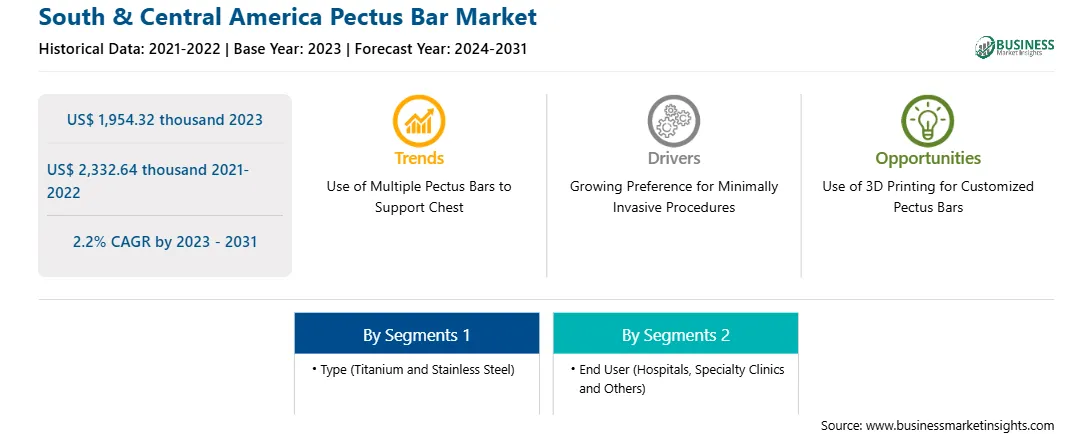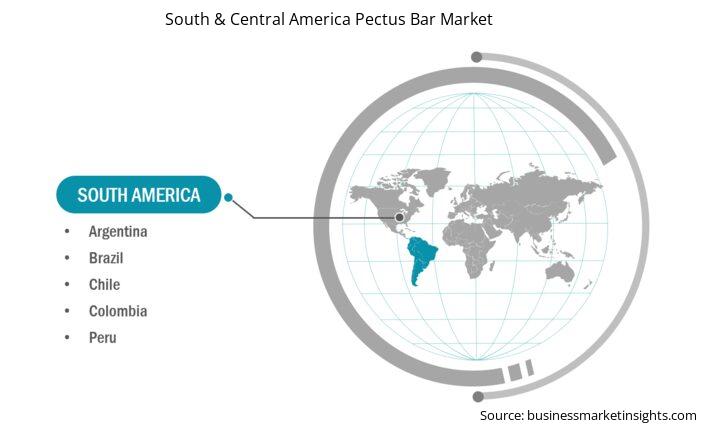The South & Central America pectus bar market was valued at US$ 1,954.32 thousand in 2023 and is expected to reach US$ 2,332.64 thousand by 2031; it is estimated to register a CAGR of 2.2% from 2023 to 2031.
The site of chest wall insertion and bar shape are currently contoured and placed on the basis of the surgeon's judgment. Bar length is determined by placing a bar-shaped phantom above the patient’s external contour while considering it should cover the space between both midaxillary lines. Sometimes, bar shape is determined based on external chest morphology and thoracic CT-scan. However, planning and standardization of the repair of complex chest wall malformations is challenging, given their inherent heterogeneity. Various studies are going on for the use of technology, especially virtual surgical planning and 3D technology, to overcome complex chest wall malformations. Virtual surgical planning has become an invaluable tool in several fields, with the goal of decreasing human error that would lead to improper fit of surgical devices and subsequent possible complications. The 3D virtual reconstruction from a computed tomography (CT) chest scan enables the surgical team to elaborate a detailed preoperative plan, including the number of implants required, their direction, and their entry points to the thoracic cavity. According to the study “Initial experience with 3D printing in the use of customized Nuss bars in pectus excavatum surgery,” published by the National Institutes of Health (NIH), in 2021, the 3D preoperative design of pectus bars with customized shape and size facilitates surgical planning. It also allows for the most optimal and accurate morphological repair possible, according to patient anatomy, thus reducing the need for additional surgical procedures. Thus, the growing focus on the use of 3D printing technology for customizing pectus bars acts as an opportunity for the pectus bars market growth.
As per an article published by the American Association for the Advancement of Science in March 2024, the prevalence of pectus excavatum in Brazil is 1.2%, and the condition is expected to affect 1 in 200 live births. Severe cases of this rare disorder may be characterized by the breastbone compressing the heart and lungs. The deformity can be treated by surgically placing an implant in the chest cavity to push the sternum forward. Brazil has a well-established medical device industry, which is regulated by the Brazilian National Health Surveillance Agency (ANVISA). Pectus bar has been registered with ANVISA, which enables the safe use of various surgical devices across the country. Further, the National Institute of Metrology, Standardization, and Industrial Quality (INMETRO) sets the standards and guidance for the medical device industry players. A novel prosthetic device developed by researchers at the University of São Paulo’s Heart Institute (INCOR) and a Brazilian company with FAPESP’s support reflects the rising awareness and research on pectus excavatum in the country. The country has the most significant medical equipment industry in the entire South & Central America, and it is the largest importer of medical equipment for the US. Moreover, the development of new and innovative products by various organizations is expected to contribute to the pectus bar market growth. In March 2024, the researchers at the University of São Paulo’s Heart Institute (INCOR) developed a biocompatible prosthetic device in collaboration with a Brazilian company FAPESP. Thus, the increasing prevalence of pectus excavatum and the presence of a well-developed and regulated medical device industry are the prime factors driving the pectus bar market growth in Brazil.
Strategic insights for the South & Central America Pectus Bar provides data-driven analysis of the industry landscape, including current trends, key players, and regional nuances. These insights offer actionable recommendations, enabling readers to differentiate themselves from competitors by identifying untapped segments or developing unique value propositions. Leveraging data analytics, these insights help industry players anticipate the market shifts, whether investors, manufacturers, or other stakeholders. A future-oriented perspective is essential, helping stakeholders anticipate market shifts and position themselves for long-term success in this dynamic region. Ultimately, effective strategic insights empower readers to make informed decisions that drive profitability and achieve their business objectives within the market. The geographic scope of the South & Central America Pectus Bar refers to the specific areas in which a business operates and competes. Understanding local distinctions, such as diverse consumer preferences (e.g., demand for specific plug types or battery backup durations), varying economic conditions, and regulatory environments, is crucial for tailoring strategies to specific markets. Businesses can expand their reach by identifying underserved areas or adapting their offerings to meet local demands. A clear market focus allows for more effective resource allocation, targeted marketing campaigns, and better positioning against local competitors, ultimately driving growth in those targeted areas.South & Central America Pectus Bar Strategic Insights

South & Central America Pectus Bar Report Scope
Report Attribute
Details
Market size in 2023
US$ 1,954.32 thousand
Market Size by 2031
US$ 2,332.64 thousand
Global CAGR (2023 - 2031)
2.2%
Historical Data
2021-2022
Forecast period
2024-2031
Segments Covered
By Type
By End User
Regions and Countries Covered
South and Central America
Market leaders and key company profiles
South & Central America Pectus Bar Regional Insights

The South & Central America pectus bar market is categorized into type, end user, and country.
Based on type, the South & Central America pectus bar market is bifurcated into titanium and stainless steel. The titanium segment held a larger market share in 2023.
In terms of end user, the South & Central America pectus bar market is segmented into hospitals, specialty clinics, and others. The hospitals segment held a larger market share in 2023.
By country, the South & Central America pectus bar market is segmented into Brazil, Argentina, and the Rest of South & Central America. Brazil dominated the South & Central America pectus bar market share in 2023.
KLS Martin Group, Biotech GmbH, IDEAR SRL, Zimmer Biomet Holdings Inc, and Ventura Medical Technologies are some of the leading companies operating in the South & Central America pectus bar market.
The South & Central America Pectus Bar Market is valued at US$ 1,954.32 thousand in 2023, it is projected to reach US$ 2,332.64 thousand by 2031.
As per our report South & Central America Pectus Bar Market, the market size is valued at US$ 1,954.32 thousand in 2023, projecting it to reach US$ 2,332.64 thousand by 2031. This translates to a CAGR of approximately 2.2% during the forecast period.
The South & Central America Pectus Bar Market report typically cover these key segments-
The historic period, base year, and forecast period can vary slightly depending on the specific market research report. However, for the South & Central America Pectus Bar Market report:
The South & Central America Pectus Bar Market is populated by several key players, each contributing to its growth and innovation. Some of the major players include:
The South & Central America Pectus Bar Market report is valuable for diverse stakeholders, including:
Essentially, anyone involved in or considering involvement in the South & Central America Pectus Bar Market value chain can benefit from the information contained in a comprehensive market report.